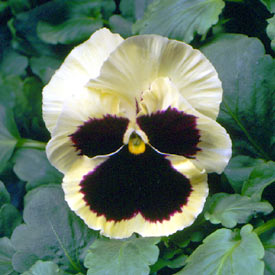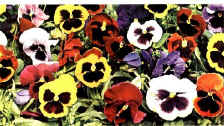|
Pansy
 Hardy
and prolific, pansies bloom during cool weather when many other
annuals have long been frosted away. In fact, pansies may be planted
in the fall in all but the coldest climates. Fall planting is best
where summers are hot; spring planting is good where summer days
seldom exceed 90 degrees. The pansy palette is huge and you can
choose between varieties with interesting blotch patterns, which
most people call "faces". There are also solid colors with
more subtle markings. Landscape type pansies generally have smaller
blooms but more of them than older, giant-flowered types. The
landscape types are often more tolerant of extremes in weather, too.
Super-tough miniature pansies, known as violas and Johnny jump-ups,
are grown just like regular pansies and are well suited to
containers. Hardy
and prolific, pansies bloom during cool weather when many other
annuals have long been frosted away. In fact, pansies may be planted
in the fall in all but the coldest climates. Fall planting is best
where summers are hot; spring planting is good where summer days
seldom exceed 90 degrees. The pansy palette is huge and you can
choose between varieties with interesting blotch patterns, which
most people call "faces". There are also solid colors with
more subtle markings. Landscape type pansies generally have smaller
blooms but more of them than older, giant-flowered types. The
landscape types are often more tolerant of extremes in weather, too.
Super-tough miniature pansies, known as violas and Johnny jump-ups,
are grown just like regular pansies and are well suited to
containers.
Care
 Because
pansies are planted in fall or early spring when soil temperatures
are cool, they benefit from special fertilizers that contain nitrate
forms nitrogen in addition to phosphorous and potassium. The nitrate
form is more available in cool soils than are other forms of
nitrogen. Look for 19-6-12 with timed-release fertilizer which contains
a high percentage of nitrate nitrogen. Before setting out your
plants, mix the fertilizer into well-cultivated soil along with a
2-inch deep layer of flower planting mix, compost, or other type of
organic matter. Take care to plant pansies at the same depth they
grew in their containers because planting too deeply can encourage
disease. Because
pansies are planted in fall or early spring when soil temperatures
are cool, they benefit from special fertilizers that contain nitrate
forms nitrogen in addition to phosphorous and potassium. The nitrate
form is more available in cool soils than are other forms of
nitrogen. Look for 19-6-12 with timed-release fertilizer which contains
a high percentage of nitrate nitrogen. Before setting out your
plants, mix the fertilizer into well-cultivated soil along with a
2-inch deep layer of flower planting mix, compost, or other type of
organic matter. Take care to plant pansies at the same depth they
grew in their containers because planting too deeply can encourage
disease.
Fertilize fall-planted
pansies again with 19-6-12 in late winter. Sprinkle the fertilizer onto the soil
between the plants and water well. This feeding will prolong the
flowering period by giving the plants the nutrients they need to
grow healthy new stems and buds. Where summers are cool, fertilize
pansies again in late summer to encourage a final flush of flowers
in the fall.
Pansies vary in
their tolerance to cold, so check with your local resources for
selections proven hardy in your area. Sometimes plants may be zapped
by a sudden hard freeze in the teens, especially if it follows a
period of mild weather so the plants have not had a chance to
prepare for cold. In this case, you may want to throw a blanket over
the plants for protection.
| 